THE
RELATIONSHIP BETWEEN OVERACTIVE BLADDER AND SEXUAL ACTIVITY IN WOMEN
(
Download pdf )
ANKUR S. PATEL, MARGIE L. O’LEARY, ROBERT J. STEIN, WENDY W. LENG, MICHAEL B. CHANCELLOR, SUBODH G. PATEL, DIANE BORELLO-FRANCE
Department of Urology (ASP, MLO, RJS, WWL, MBC), University of Pittsburgh Medical Center, Pittsburgh, Pennsylvania, Uniontown Hospital (SGP), Uniontown, Pennsylvania, and Department of Physical Therapy (DBF), Duquesne University, Pittsburgh, Pennsylvania, USA
ABSTRACT
Purpose:
We assessed the relationships between bladder symptoms, demographic, and
medical history variables and sexual dysfunction in women with overactive
bladder (OAB) disorder.
Materials and Methods: Seventy-eight women
diagnosed with OAB completed self-administered questionnaires related
to overall heath status, bladder function, and sexual function. Data were
compiled for questionnaire responses, and multivariate logistic regression
analyses were performed to determine predictors of sexual dysfunction.
Results: Bothersome bladder symptoms were
reported by ³ 60% of the sample. Sixty-percent of the sample was
sexually active in the past month. Difficulty with sexual arousal, orgasm,
and sexual enjoyment were reported by about 25% of the women. Sexual partner
status was the best predictor of sexual arousal, orgasm, and sexual enjoyment.
Menopausal status emerged as an important predictor of arousal and sexual
enjoyment.
Conclusion: The majority of women with symptoms
of OAB viewed these symptoms as bothersome. However, the extent of symptom
bother did not predict aspects of female sexual dysfunction (FSD). Instead,
menopausal and partner status emerged as the best predictors of FSD in
our sample.
Key
words: urination disorders; female; overactive bladder; sexual
dysfunction; menopause
Int Braz J Urol. 2006; 32: 77-87
INTRODUCTION
Although
reported estimates of sexual dysfunction are higher for women than men
(43% versus 31%, respectively), fewer treatment options for female sexual
dysfunction (FSD) exist (1). As treatments for male sexual dysfunction
have become safer and more effective, both individuals and the medical
community are seeking beneficial therapies for FSD.
According to the World Health Organization
(2) and the Diagnostic and Statistical Manual of Mental Disorders (3),
FSD is classified into disorders of desire (hypoactive sexual desire,
sexual aversion), arousal, orgasm, and pain (dyspareunia and vaginismus).
Physiologic, iatrogenic, and psychological factors place women at risk
for developing FSD. Physiologic and iatrogenic factors include abdominal
surgery (e.g., hysterectomy), menopause, smoking, spinal cord injury,
and certain medications (e.g., birth control pill, antipsychotics, antihypertensives,
antidepressants, etc.). Psychologic factors include anxiety, depression,
negative body perception, history of physical or emotional abuse, and
stress.
Overactive bladder (OAB) disorder may also
contribute to the development of FSD (4). According to the International
Continence Society (5), OAB disorder is classified as a symptom syndrome
suggestive of lower urinary tract dysfunction. Symptoms of OAB include
urinary urgency, urinary frequency, and urge urinary incontinence. Overactive
bladder drastically reduces quality of life by its negative influence
on a person’s ability to work, travel, sleep, exercise, socialize,
and participate in intimate relationships (4).
In current health care practices, family
physicians, not specialists, are most likely to manage the treatment of
OAB in women. Discussions regarding bladder symptoms between patients
and their physicians are occurring more frequently. In addition, family
care physicians have enhanced access to diagnostic testing and safer and
more effective medications to treat OAB.
Conversely, discussion and assessment of
female sexual health occurs much less frequently. This may be partially
attributed to the opinion that the origin of FSD is more psychological
than physical. Women might also believe that sexual health is a topic
that should discussed with a specialist, such as her gynecologist. Likewise,
if her family physician fails to ask about sexual health, she may avoid
discussion based on the belief that her family physician is uncomfortable
with the topic. Limited familiarity with sexual health assessments and
treatment options may further prevent the physician from discussing FSD
with a patient (6). Discussion regarding sexually related issues are highly
challenging within primary care because of their sensitivity, complexity,
and constraints of time and expertise (7).
On the contrary, men have many options when
seeking treatment for erectile dysfunction. They may actually arrive at
their primary-care appointment seeking treatments as a result of increased
direct-to-consumer advertising by pharmaceutical companies. In the near
future, women may be more willing to discuss their sexual health as FDA
approved medications to treat FSD enter the market.
In the case of FSD, family physicians lack
easy access to physiological measures of patients’ experiences.
Symptom-related and health-related quality of life (HRQOL) measurements
may provide useful information to guide treatment selection and to evaluate
treatment effectiveness.
Since female sexual health problems are
often undiagnosed and untreated, our first study aim was to enhance awareness
by describing sexual health in a sample of women with OAB using symptom-related
and HRQOL measures. Because control of bladder and sexual function occurs
through shared neurologic pathways, we also aimed to investigate the extent
that bladder dysfunction and demographic and medical history variables
predicted sexual dysfunction. We hypothesized that the likelihood of sexual
dysfunction would be associated with higher levels of distress related
to bladder symptoms.
MATERIALS AND METHODS
One
hundred fifty female patients from a suburban general urology practice,
between the ages of 35-70 years, with clinically documented OAB symptoms
(within a 12-month period) were asked to participate in this study. Data
were obtained via self-administered questionnaires that were mailed to
participants. The questionnaires included: the Urinary Distress Inventory-Short
Form (UDI), the Personal Experiences Questionnaire (PEQ), and a demographic
and medical history questionnaire. The respondents completed all questionnaires
anonymously.
The UDI assesses the presence and degree
of bother associated with bladder symptoms, including urge incontinence,
stress incontinence, small volume leakage, difficulty emptying the bladder,
and pain in the lower abdominal area (8). Psychometric properties including
internal consistency, concurrent (with UDI, long version) and construct
validity, and sensitivity to change of the UDI have been reported (8).
The PEQ includes a subset of eleven items
derived from the McCoy Female Sexuality Questionnaire (9). Items included
sexual frequency, sexual arousal, frequency of orgasm, pain during intercourse,
feelings towards partner, and partner problems. Despite limited information
on its reliability and validity characteristics, we chose the PEQ for
its brevity, ease of completion, and face validity.
Women also completed a demographic and medical
history questionnaire. This questionnaire elicited descriptive information
regarding age, marital status, race, disability, menopausal status, sexual
partner, depression, and past surgeries.
Data
Analysis
Means, standard deviations, and percentages
were calculated in order to describe the sample with respect to demographic
and medical history variables. Percentages were calculated to describe
responses to the UDI and PEQ questionnaires.
For statistical analyses, the questionnaire
responses were collapsed into smaller categories. Urogenital Distress
Inventory responses “not at all”, “slightly”,
“moderately”, and “greatly” were collapsed into
“not at all bothered” and “bothered” categories.
The PEQ includes a semantic differential rating scale, with assigned values
from 1 (“not at all”) to 6 (“a great deal”). For
our analyses, values 2 and 3 were collapsed to create a “sometimes”
category, and values 4,5, and 6 were collapsed to create “a great
deal” category.
Multivariate logistic regression (MLR) was
used to analyze factors associated with the likelihood of sexual dysfunction.
Potential factors (age, menopausal status, depression, available sexual
partner, bladder symptom-related distress) identified using univariate
logistic regression analyses as having a relationship (p £ .10)
with sexual function were used in the MLR procedure to identify the best
subset of variables associated with sexual dysfunction.
RESULTS
Patient
Description
One hundred women returned the completed
questionnaires. Twenty-two indicated a medical history of neurologic disease
or injury. Data from these 22 women were excluded, leaving usable questionnaire
data from 78 women. The mean sample age was 50 ± 6 years, and 87%
of the women were Caucasian. Fifty percent of the respondents were married,
14.1% were single, 12.8% were divorced, and 11.5% were widowed. Ninety-six
percent of the sample was heterosexual and 72% indicated that they had
a current sexual partner.
The percent of women indicating co-morbid
medical conditions is shown in Figure-1. Hypertension and depression were
the most common co-morbid conditions. Forty-seven percent of the sample
indicated current treatment for depression.
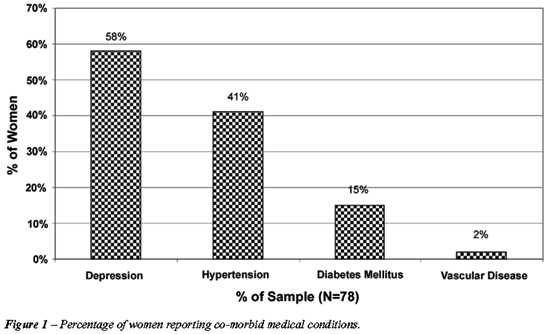
Bladder
Symptom and Sexual Function Question Results
The distribution of reported bladder symptoms
are shown in Figure-2. Frequent urination, urge incontinence, small volume
leaks, and stress incontinence were all reported by ³ 60% of the
sample. Difficulty voiding and pain in the lower abdominal/genital area
were reported by less than 40% of the sample. Across all symptoms, 99-100%
of the women reporting a symptom indicated that the symptom was bothersome.
Responses to the sexual function questionnaire items are shown in Figure-3.
Inabilities to become sexually aroused, experience orgasm, and enjoy sex
were reported by 24%, 27%, and 27% of the women, respectively. Twenty-five
percent of the women were dissatisfied with their partner as a lover.
Thirty-six percent of respondents had a partner who experienced difficulty
in sexual performance.
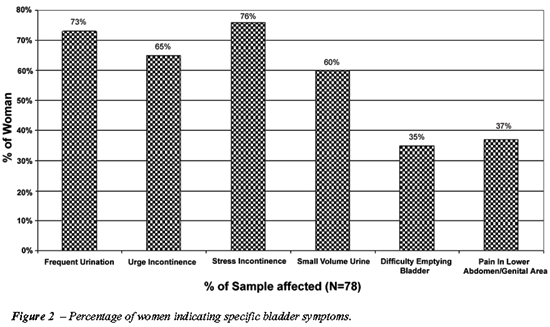
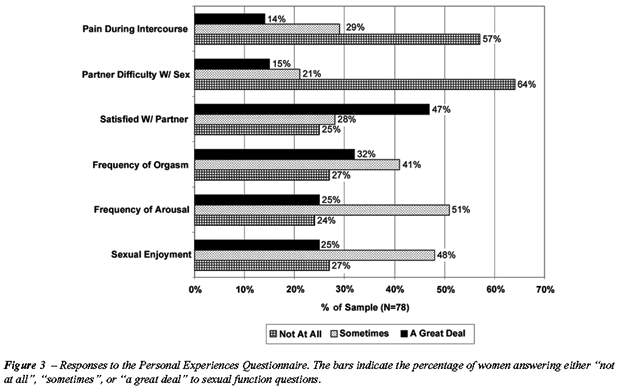
Figures-4 and 5, show the frequency of sexual
thoughts/fantasies and sexual activity responses. In the past month, 29%
had not experienced sexual thoughts or fantasies and 40% of the respondents
had not engaged in sexual activity.
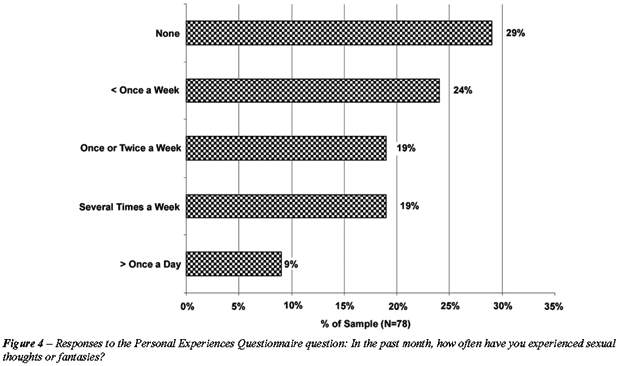
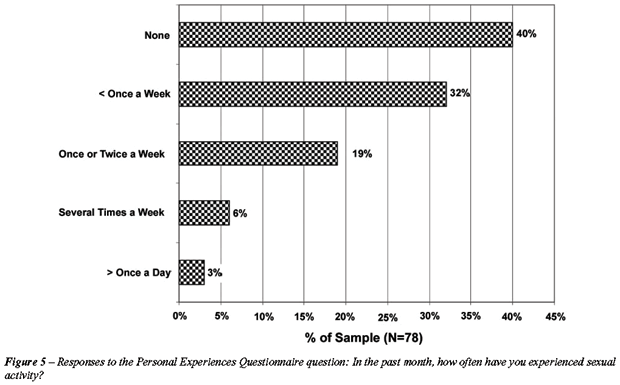
Univariate
Logistic Regression Analyses
Tables-1 to 3 show the results of the univariate
logistic regression analyses. Sexual partner status was the only independent
variable that displayed a statistically significant association with arousal
(p < 0.05). The association with menopausal status approached statistical
significance (p = 0.08). These variables were retained for a MLR model
to identify the best subset of variables indicative of a dysfunction in
sexual arousal.
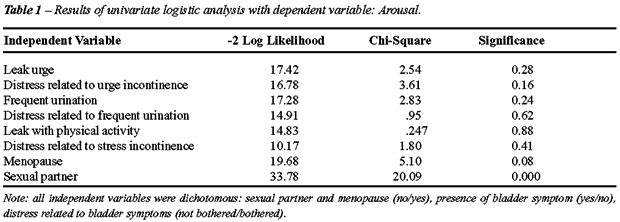
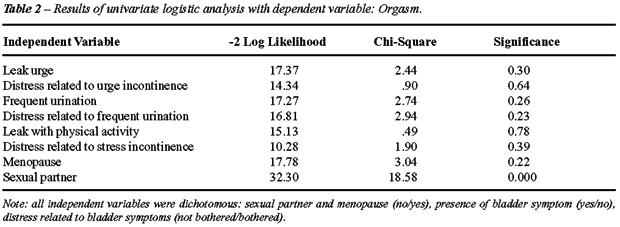

Sexual partner status was the only independent
variable that displayed a statistically significant (p < 0.05) relationship
with orgasm. Women lacking a sexual partner were almost 22 times more
likely to experience anorgasm compared to women with a sexual partner
(see Table-4).

Independent variables showing associations
with sexual enjoyment included sexual partner status (p = 0.00), menopausal
status (p = 0.09), and urge incontinence (p = 0.10). These 3 variables
were retained for the MLR model to identify the best subset of predictors
of low sexual enjoyment.
Multivariate
Logistic Regression Analyses
Tables-5 and 6 show the odds ratios and
confidence intervals for each independent variable tested in the models
predicting sexual arousal and enjoyment dysfunction. The model for predicting
sexual arousal dysfunction (Table-5) showed statistical significance.
Sexual partner status was most influential in predicting the inability
to become sexually aroused. Women without a sexual partner were almost
22 times more likely to report an inability to become sexually aroused
compared to women with a sexual partner. Neither sexual partner nor menopausal
status emerged as predictors of arousal “sometimes”.


The model for predicting the failure to
enjoy sexual activities also showed statistical significance (Table-6).
Lacking sexual partner was the best predictor of the failure to enjoy
sexual activities. Women without a partner were over 14 times more likely
to report that sexual activities were “not at all enjoyable”
compared to women with a sexual partner. In addition, postmenopausal women
were almost 5 times more likely to report sexual activities that were
“not enjoyable at all” compared to pre-menopausal women.
COMMENTS
Prevalence
of Bladder Symptoms and Sexual Dysfunction
The primary aim of this study was to describe
sexual health in a sample of women with OAB. Female sexual dysfunction
and OAB syndrome share many risk factors including age, medications, smoking,
hormonal changes, hysterectomy, and uterine prolapse (10). In this study,
women who reported symptoms of urinary frequency, stress, and urge incontinence
indicated that these symptoms were indeed bothersome. Others have reported
the impact of OAB on quality of life. Women with urinary incontinence
feel social isolation, depressive symptoms, anxiety, humiliation, and
loss of self-confidence (11).
Approximately 25% of our sample of women
with OAB identified some form of sexual dysfunction. In addition, 40%
indicated that they did not engage in sexual activity during the month
surveyed. Although women in our study reported both bladder and sexual
dysfunction, we did not find statistically significant associations between
the two disorders. However, Salonia (12) demonstrated that sexual function
is negatively affected in women with bladder dysfunction.
Pain
and Sexual Function
Almost 40% of our sample indicated that
they experienced bothersome pain in their abdominal/genital area. In our
study, we did not find abdominal/genital pain a significant predictor
of sexual dysfunction. Based on findings of a national study including
1749 women, Laumann et al. reported that urinary tract symptoms contributed
to arousal and pain disorders in women (1). Meana et al., reported that
women with dyspareunia had greater sexual dysfunction and psychologic
distress compared to age-matched women without dyspareunia (13). The disparity
between these published studies and our results could reflect a difference
in the primary symptom complaint of our sample. A urologist was examining
the women surveyed for the primary complaint of OAB, not abdominal/pelvic
pain.
Menopausal
Factors and Sexual Function
Gynecologic changes occurring during menopause
include vaginal atrophy and dryness, urinary incontinence, and infections.
A loss of pelvic floor muscle tone or diminished capability of the intrinsic
urethral sphincter, which can cause incontinence and decreased maximum
urethral closing pressures may also occur (14). Decreases in sexual activity
are also associated with estrogen level decline and testosterone level
fluctuation (15).
Our results indicated that menopausal status
was a statistically significant predictor of sexual enjoyment. Postmenopausal
women in our study were almost 5 times more likely to report “not
enjoyable” sexual activities compared to pre-menopausal women. Dennerstein
et al. also demonstrated significant changes in sexual function during
menopause related to sexual desire, frequency, response, and feelings
toward the sexual partner (16). Likewise, Blumel et al. showed that Chilean
women, aged 40-64, reported decreased or absent sexual activity as they
transitioned to menopause (17). Even when age was held constant, menopausal
symptoms were determined to be significant factors in ceasing sexual activity.
Long-term absence of sexual function accompanied
by a lack of estrogen post-menopause can cause vaginal atrophy and dryness.
These physiological changes make sexual activity difficult as vaginal
stretching capacity is diminished.
Post-menopausal sexual function may also
be limited by depressive symptoms. Freeman observed that increases in
depressive symptoms occurred as women transitioned into menopause and
demonstrated fluctuating estradiol levels (18). Although we did not find
depression to be a predictor of sexual dysfunction, 47% of our sample
did indicate that they were receiving treatment for depression.
Partner Effect
Our data showed that sexual partner status
was the best predictor of sexual arousal, orgasm, and sexual enjoyment.
Twenty-eight percent of our sample did not have a current sexual partner.
Reasons for lacking a partner can include death of spouse, divorce, history
of depression, previous negative sexual experience, career aspirations,
or competing family demands. One limitation of our study is that we did
not elicit specific reasons for lacking a sexual partner from our sample.
Such reasons could have confounded our results by inflating the importance
of sexual partner status as a predictor of sexual function. For example,
social and family structure changes that occur in the middle-age years
can create changes in daily life activities. The additional responsibility
of caring for elderly parents or grandchildren could impact sexual function
by limiting time to devote toward partner relationships.
Another limitation of our study is that
we did not thoroughly explore the impact of other partner variables on
FSD. Thirty-five percent of our sample indicated that they had a partner
who experienced difficulty in sexual performance and 24% admitted that
they were dissatisfied with their partner as a lover. We did not elicit
from these women the reasons for their dissatisfaction. Aside from partner
difficulties, the quality of the sexual experience may have been an important
factor to consider. Young showed that the consistent ability of both partners
to achieve orgasm had an impact on female sexual satisfaction (19). Pre-coital
caressing and frequent coitus have also been reported by women to be important
to sexually satisfying marital relationships (20). Because partner status
emerged as such a strong predictor of sexual function, future research
should include a thorough exploration of partner-related variables.
CONCLUSION
Although this study sample consisted of women seeking care from a urologist, our results are relevant to the family practice field. Family physicians are assessing and treating bladder symptoms at increasingly high rates. In addition, FSD is still not a topic commonly discussed in a primary care visit. Since FSD directly impacts quality of life, family care physicians should discuss FSD with all female patients. Based on our results, particular attention should be directed to menopausal women and women lacking a sexual partner as they are more likely to be experiencing sexual dysfunction.
ACKNOWLEDGEMENT
This work was supported by the Center of Urology Research Excellence-Spinal Cord Injury (CURE-SCI)
CONFLICT OF INTEREST
None declared.
REFERENCES
- Laumann EO, Paik A, Rosen RC: Sexual dysfunction in the United States: prevalence and predictors. JAMA. 1999; 281: 537-44. Erratum in: JAMA 1999; 281: 1174.
- World Health Organization: ICD-10: International Statistical Classification of Diseases and Related Health Problems, ed. 10. Geneva, World Health Organization. 1992.
- American Psychiatric Association. DSM-IV: Diagnostic and Statistical Manual of Mental Disorders. Washington, American Psychiatric Association. 1994.
- Jackson S: The patient with an overactive bladder—symptoms and quality-of-life issues. Urology. 1997; 50 (6A Suppl): 18-22; discussion 23-4.
- International Continence Society: First report on the standardization of terminology of lower urinary tract function. Br J Urol. 1976; 48: 39-42.
- Sarkadi A, Rosenqvist U: Contradictions in the medical encounter: female sexual dysfunction in primary care contacts. Fam Pract. 2001; 18: 161-6.
- Gott M, Galena E, Hinchliff S, Elford H: “Opening a can of worms”: GP and practice nurse barriers to talking about sexual health in primary care. Fam Pract. 2004; 21: 528-36.
- Uebersax JS, Wyman JF, Shumaker SA, McClish DK, Fantl JA: Short forms to assess life quality and symptom distress for urinary incontinence in women: the Incontinence Impact Questionnaire and the Urogenital Distress Inventory. Continence Program for Women Research Group. Neurourol Urodyn. 1995; 14: 131-9.
- McCoy NL: The McCoy Female Sexuality Questionnaire. Qual Life Res. 2000; 9: 739-45.
- Bachmann GA, Leiblum SR: The impact of hormones on menopausal sexuality: a literature review. Menopause. 2004; 11: 120-30.
- Temml C, Haidinger G, Schmidbauer J, Schatzl G, Madersbacher S: Urinary incontinence in both sexes: prevalence rates and impact on quality of life and sexual life. Neurourol Urodyn. 2000; 19: 259-71.
- Salonia A, Munarriz RM, Naspro R, Nappi RE, Briganti A, Chionna R, et al.: Women’s sexual dysfunction: a pathophysiological review. BJU Int. 2004; 93: 1156-64.
- Meana M, Binik YM, Khalife S, Cohen DR: Biopsychosocial profile of women with dyspareunia. Obstet Gynecol. 1997; 90: 583-9.
- Goldberg RP, Sand PK: Pathophysiology of the overactive bladder. Clin Obstet Gynecol. 2002; 45: 182-92.
- Gracia CR, Sammel MD, Freeman EW, Liu L, Hollander L, Nelson DB: Predictors of decreased libido in women during the late reproductive years. Menopause. 2004; 11: 144-50.
- Dennerstein L, Dudley E, Burger H: Are changes in sexual functioning during midlife due to aging or menopause? Fertil Steril. 2001; 76: 456-60.
- Blumel JE, Castelo-Branco C, Cancelo MJ, Romero H, Aprikian D, Sarra S: Impairment of sexual activity in middle-aged women in Chile. Menopause. 2004; 11: 78-81.
- Freeman EW, Sammel MD, Liu L, Gracia CR, Nelson DB, Hollander L: Hormones and menopausal status as predictors of depression in women in transition to menopause. Arch Gen Psychiatry. 2004; 61: 62-70.
- Young M, Denny G, Young T, Luquis R: Sexual satisfaction among married women age 50 and older. Psychol Rep. 2000; 86: 1107-22.
- Zhou M: A survey of sexual states of married, healthy, reproductive age women. J Psychol Human Sex. 1993; 6: 15-28.
_________
Accepted:
September 5, 2005
_______________________
Correspondence address:
Dr. Michael B. Chancellor
Kaufmann Building
3471 Fifth Avenue Suite 700
Pittsburgh, Philadelphia, 15213, USA
Fax: + 1 412 692-4101
E-mail: chancellormb@upmc.edu